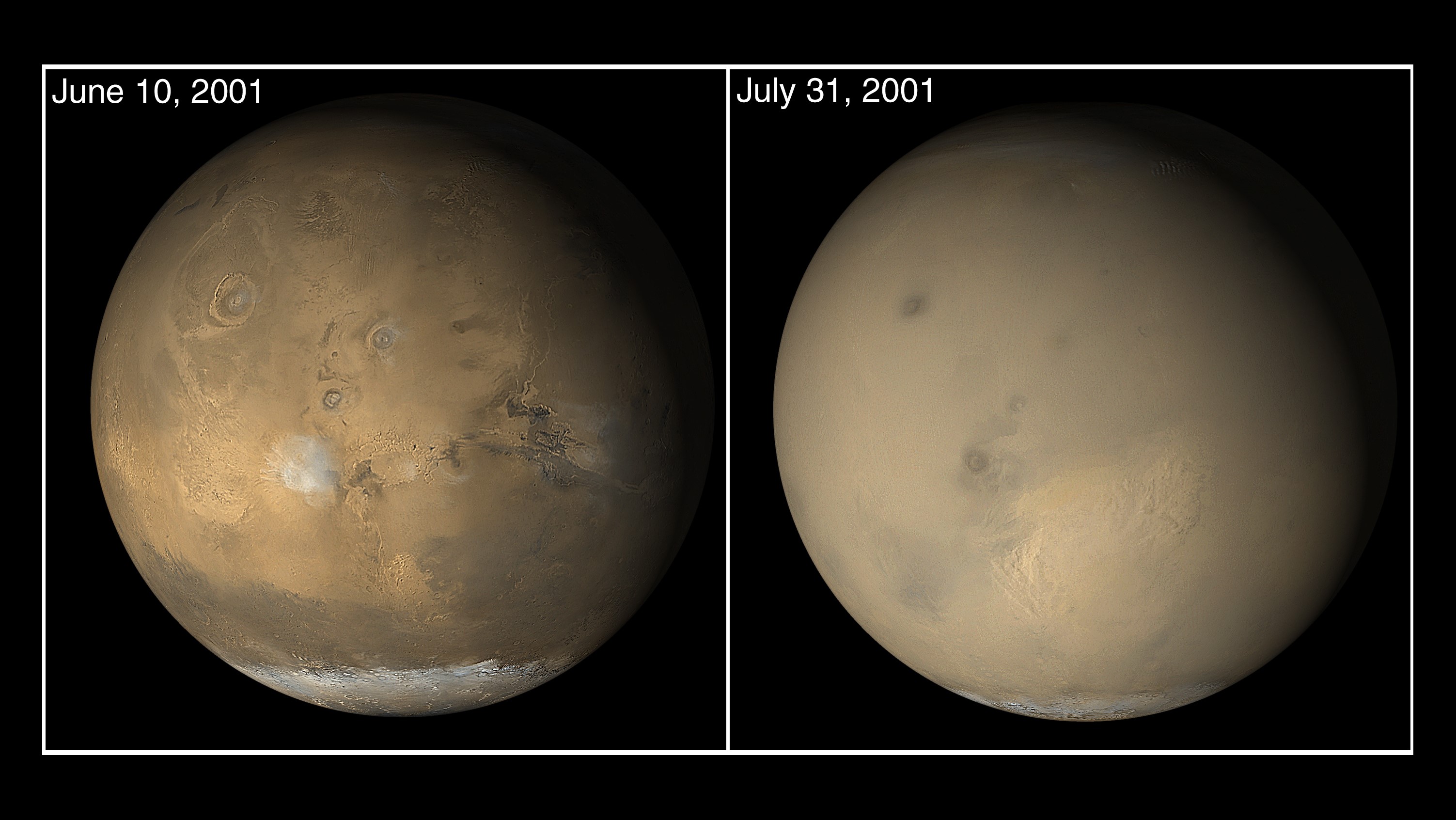Massive Mars dust storms triggered by heat imbalances, scientists find

Mars' planet-engulfing dust storms are being driven by a dramatic energy imbalance between seasons and even between day and night on the Red Planet, new research has found.
"One of the most interesting findings is that energy excess — more energy being absorbed than produced — could be one of the generating mechanisms of dust storms on Mars," said Ellen Creecy in a statement. Creecy is a doctoral student at the University of Houston and lead author of the new research.
Mars is famous for its dust storms, which tend to whip up during summertime in the planet's southern hemisphere. Often they can grow to encompass a substantial region of the Red Planet. For example, in January 2022, a dust storm covering nearly twice the area of the United States led to some of NASA's Mars missions having to be powered down until the storm passed. A global dust storm also put an end to the agency's Opportunity rover in 2018.
Related: A giant Mars dust pile is sculpted by the wind in this photo by a European probe
Planetary scientists have long pondered where the energy to drive these vast storms originates from. Solar heating clearly has something to do with it, given the connection between dust storms and southern summer, but the extreme nature of the storms suggests that it's more complex.
Now new research, based primarily on observations by NASA's now-defunct Mars Global Surveyor (MGS) spacecraft, which operated from 1996 to 2006, and its Thermal Emission Spectrometer. The scientists also incorporated newer measurements of surface temperature from the Curiosity rover and the InSight lander, which are both still operating today. All told, the researchers found that dust storms are strongly related to the imbalance between the amount of solar energy being absorbed by Mars and the amount of energy it then re-radiates as heat.
In technical parlance, this relationship between absorbing and re-radiating heat is referred to as the radiation energy budget. It's different for each planet. The gas giant planets — Jupiter, Saturn and so on — have a large imbalance because their great distance from the sun means they receive relatively little solar energy, but they re-radiate a lot because they still have substantial amounts of interior heat left over from their formation.
Breaking space news, the latest updates on rocket launches, skywatching events and more!
Earth, on the other hand, has a small imbalance of between 0.2% and 0.4%, meaning that the amount of heat that the planet absorbs and the amount that it re-radiates back into space is about the same. This is thanks in part to the ability of our oceans and atmosphere to trap and redistribute heat around the planet.
The prevailing assumption had been that Mars also has a small imbalance, but the new work shows that is not the case, which can lead to marked differences between the two hemispheres, particularly during southern summer and northern winter.
In 2001, a global dust storm engulfed Mars, and MGS was on hand to study the storm in detail. The spacecraft found that during this great storm, there was an energy imbalance between the northern and southern hemispheres of the Red Planet of 15.3%. The extra energy absorbed by the southern hemisphere was more than enough to power the huge dust storms.
Furthermore, the imbalance between day and night is even more startling. During the 2001 dust storm, the global average emitted heat decreased by 22% from the global average (111.7 watts per square meter) during the day, but increased by 29% at night. The presence of heat-absorbing dust suspended in the atmosphere during the storm is partly responsible for this imbalance, but the main cause is the lack of large oceans or a thick atmosphere, the researchers said.
"Mars is not a planet that has any kind of real energy storage mechanisms like we have on Earth," Creecy said. "Our large oceans, for example, help to equilibrate the climate system."
Once upon a time, Mars had oceans and a thicker atmosphere itself, but the oceans dried up over 3 billion years ago and the atmosphere was mostly lost to space. This history implies that the energy imbalance — and the dust storms that the imbalance drives — are a product of climate change on Mars. Hence, Mars may provide a preview of what's in store for Earth, either if runaway climate warming takes hold, or about a billion years in the future when an aging sun will have grown too hot for oceans to exist on our planet.
Meanwhile, on Mars, the dust storm season will gear up again in the next few months, with the Red Planet's southern hemisphere passing its spring equinox in February 2022, according to the Planetary Society. This means there's no respite from the dust for the various rovers and landers on the Martian surface — at least until the next southern winter in 2023.
The research is described in a paper published May 16 in the journal Proceedings of the National Academy of Sciences.
Follow Keith Cooper on Twitter @21stCenturySETI. Follow us on Twitter @Spacedotcom and on Facebook.

Keith Cooper is a freelance science journalist and editor in the United Kingdom, and has a degree in physics and astrophysics from the University of Manchester. He's the author of "The Contact Paradox: Challenging Our Assumptions in the Search for Extraterrestrial Intelligence" (Bloomsbury Sigma, 2020) and has written articles on astronomy, space, physics and astrobiology for a multitude of magazines and websites.


